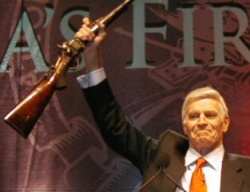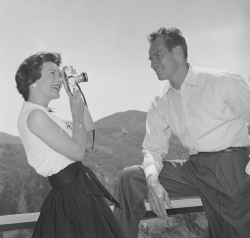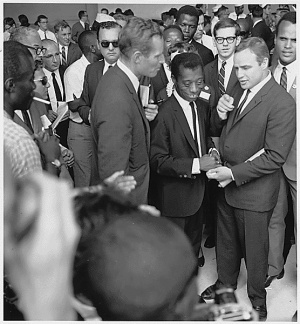Charlton Heston
While well known for his support for gun rights in his later life, few realize that his political activist history went back much further — in the 1950s and 1960s he was one of only a handful of Hollywood actors to speak openly against racism and was an active supporter of the Civil Rights Movement. Initially a moderate Democrat, he later supported conservative Republican policies and also served on the Advisory Board of Accuracy in Media, a conservative media watchdog group founded by Reed Irvine.
Contents |
Personal life
Heston was born John Charles Carter, the only child of Lilla (née Charlton; 1899–1994) and Russell Whitford Carter (1897–1966), a mill operator. Most sources state that he was born in Evanston, Illinois.[2] Heston's autobiography,[3] however, and some other sources place his birth in No Man's Land, Illinois, which usually refers to a then-unincorporated area now part of Wilmette, Illinois, a well-off northern suburb of Chicago. The confusion stems from Heston being born in an Evanston hospital at a time when the family lived in the Wilmette area. Heston said in a 1995 interview that he was not very good at remembering addresses or his early childhood.[4]
Heston was of English and Scottish descent and a member of the Fraser clan.[5]
In his autobiography, Heston refers to his father participating in his family's construction business.[3] When Heston was an infant his father's work moved the family to St. Helen, Michigan. It was a rural, heavily forested part of the state, and Heston lived an isolated yet idyllic existence spending much time hunting and fishing in the backwoods of the area. Heston frequently recounted that, while growing up there, he often wandered in the forest, "acting" out the characters from books he had read.[6]
When Heston was 10 years old, his parents divorced. Shortly thereafter, his mother married Chester Heston. The new family moved back to Wilmette. Heston (his new surname) attended New Trier High School, where he enrolled in the drama program, playing in the silent 16 mm amateur film adaptation of Peer Gynt, from the Ibsen play, by future film activist David Bradley released in 1941.[7]
Throughout Heston's life he was known by friends as "Chuck" although his wife always called him "Charlie." His stage name Charlton Heston is drawn from his mother's maiden surname (Charlton) and his stepfather's surname (Heston), and was used for his first film, Peer Gynt. Later, he earned a drama scholarship to Northwestern University.
In 1944, Heston enlisted in the US Army Air Forces. He served for two years as a radio operator and aerial gunner aboard a B-25 Mitchell with the Eleventh Air Force. He reached the rank of Staff Sergeant. Heston married Northwestern University student Lydia Marie Clarke in the same year he joined the military. They would remain together until his death in 2008.
Career
Theater and television
After the war, Heston and Clarke lived in Hell's Kitchen, New York City, where they worked as artists' models. After he and Lydia had managed a playhouse in Asheville, North Carolina in 1947 for $100 a week, they went back to New York in 1948 where Heston was offered a supporting role in a Broadway revival of Shakespeare's Antony and Cleopatra. He also had success in television, playing a number of roles in CBS's Studio One, one of the most popular shows of the 50s.
Film producer Hal B. Wallis of Casablanca spotted him in a 1950 television production of Wuthering Heights and offered him a contract. When his wife reminded Heston they had decided to pursue theater and television, he replied, "Well, maybe just for one film to see what it's like."
Hollywood
The full range of his talent was eventually shown in such varying films as Touch of Evil (1958), El Cid ('61), Will Penny and Planet of the Apes (both in '68), Julius Caesar ('70), and the cult classics The Omega Man ('71) and Soylent Green ('73). His only real flop was a big one — in 1972, he made his directorial debut and starred as Mark Antony in an adaptation of the play he had performed in his theater days, Antony and Cleopatra. The end product was apparently so gawd-awful bad, and the reviews so brutal, it never saw theaters and only rarely pops up on TV. It hasn't been (and likely won't be) put out on DVD.
In 1965, he became president of the Screen Actors Guild until 1971, the second longest tenure to date.[8]
Starting with playing Cardinal Richelieu in 1973's The Three Musketeers, Heston was seen in more and more supporting roles, cameos and theater. From 1985-87, he starred in his only prime-time stint on series television in The Colbys. With his son Fraser, he produced and also starred in several TV movies, including a remake of Treasure Island. In '92, he appeared in a short series of videos on A&E reading passages from the King James Bible, called Charlton Heston Presents the Bible. Filmed in the Middle East, it received excellent reviews and was a hit on video and DVD.
Never taking himself too seriously, he did a cameo in Wayne's World 2 (the scene where Wayne Campbell asks for a small role to be filled by a better actor). After the scene is reshot with Heston, Campbell weeps in awe. That same year, he hosted Saturday Night Live, had cameos in the films Hamlet, Tombstone and True Lies, and starred in many theatre productions at the LA Music Center. In 2001, he did a cameo as an old, dying chimp in the remake of Planet of the Apes. His last film role was as the infamous Nazi doctor Josef Mengele in My Father, Rua Alguem 5555, which had limited release (mainly to festivals) in 2003.
He played the title role in Mister Roberts three times and it was one of his favorite parts. In the early '90s, he tried to revive and direct the show with Tom Selleck in the title role.[9]
Activism
A Democrat in his younger days, Heston campaigned for Presidential candidate Adlai Stevenson in 1956 and John F. Kennedy in 1960. When he got wind of the news that an Oklahoma movie theater premiering his movie El Cid was segregated, he joined a picket line outside in 1961[10], much to the discombobulation of Allied Artists, the producers of the film. He also went to Oklahoma City to picket segregated restaurants, to the even further chagrin of Allied Artists.[11] During the March on Washington for Jobs and Freedom held in Washington, D.C. in 1963, he accompanied Martin Luther King Jr. In later speeches, Heston pointed out that he helped the civil rights cause "long before Hollywood found it fashionable."[12]
After the assassination of President Kennedy in 1963, Heston and several other actors issued a statement calling for support of President Johnson's Gun Control Act of 1968.[13][14] He would later regret the action, saying he wished he "could blame that on the idealistic foolishness of youth. Unfortunately, that avenue is closed to men when they reach the age of 40."
He opposed the Vietnam War and in 1969 was approached by the Democratic Party to run for the U.S. Senate. He agonized over the decision, but ultimately could never give up acting.[15]
By the 1980s, Heston opposed affirmative action, supported gun rights and changed his political affiliation from Democratic to Republican. When asked why he changed political alliances, Heston replied "I didn't change. The Democratic party changed." [16] He campaigned for Republicans and Republican Presidents Ronald Reagan, George H. W. Bush and George W. Bush.
Maintaining the distaste for racism he had ever since his days in the civil rights movement, he resigned from Actors Equity, noting that the union's refusal to allow a white actor to play a Eurasian role in Miss Saigon was "obscenely racist".
At a Time Warner stockholders meeting, Heston castigated the company for releasing an Ice-T album which included the song "Cop Killer", which depicted the killing of police officers.
While filming The Savage, Heston was initiated by blood into the Miniconjou Lakota Nation, but claimed no natural American Indian heritage (his great-great-granny was not a Cherokee princess). He claimed to be "native American" to reclaim the term from exclusion to American Indians.[3]
In a 1997 Fighting the Culture War in America speech, Heston rhetorically deplored a culture war he said was being conducted by a generation of media, educators, entertainers, and politicians against:
"...the God fearing, law-abiding, Caucasian, middle-class Protestant - or even worse, evangelical Christian, Midwestern or Southern - or even worse, rural, apparently straight - or even worse, admitted heterosexuals, gun-owning - or even worse, NRA-card-carrying, average working stiff - or even worse, male working stiff - because, not only don’t you count, you are a down-right obstacle to social progress. Your voice deserves a lower decibel level, your opinion is less enlightened, your media access is insignificant, and frankly, mister, you need to wake up, wise up, and learn a little something from your new-America and until you do, would you mind shutting up?"[17]
In an address to students at Harvard Law School entitled Winning the Cultural War, Heston said, "If Americans believed in political correctness, we'd still be King George's boys - subjects bound to the British crown."[18]
Heston later stated, "Political correctness is tyranny with manners."
In a speech to the National Press Club in 1997: "Now, I doubt any of you would prefer a rolled up newspaper as a weapon against a dictator or a criminal intruder." [19]

In the 2002 film Bowling for Columbine, Michael Moore interviewed Heston in his home, peppering him with questions about the NRA, school shootings, and an April 1999 NRA meeting held shortly after the Columbine high school massacre, in Denver, Colorado (the footage described above was used as if it were from that meeting when, in fact, it was not). Moore criticized Heston for the perceived thoughtlessness in the timing and location of the meeting. Heston, realizing he had been ambushed, excused himself and walked out. Moore was later criticized, even in the broader mainstream media, for his underhanded behavior.
Actor George Clooney tastelessly joked about Heston's failing health at a 2003 award ceremony, saying that Heston "announced again today that he is suffering from Alzheimer's." When questioned, Clooney said Heston deserved whatever was said about him for his involvement with the NRA.[21] Heston responded by saying Clooney lacked class and that he felt sorry for him, as Clooney had as much of a chance of developing Alzheimer's as anyone else.[22]
Later life and death
Heston had a hip replaced in 1996 and was diagnosed with prostate cancer in 1998, which went into remission after radiation treatment. In 2000, he publicly disclosed that he had been treated for alcoholism at a Utah clinic that year[23] and, on August 9, 2002, Heston publicly announced he was diagnosed with symptoms consistent with Alzheimer's disease.[24] In July 2003, he received the Presidential Medal of Freedom at the White House from President George W. Bush.
In March 2005, various newspapers reported that family and friends were shocked by the progression of his illness, and that he was sometimes unable to get out of bed. In August 2005, it was reported that Heston was hospitalized at a Los Angeles hospital with pneumonia, but this was never confirmed by his family or spokesman. In April 2006, various news sources reported that Heston's illness was at an advanced stage and that his family was worried he might not survive the year. In March 2008, just a few weeks before his death, it was reported that he was now in the final stages of Alzheimer's.
Heston died on Saturday, April 5, 2008, at his home in Beverly Hills, California, with Lydia, his wife of 64 years, by his side. He was also survived by his son, Fraser Clarke Heston, and adopted daughter, Holly Ann Heston. The cause of death was not disclosed by the family[25], who instead released a statement, reading, "Charlton Heston was seen by the world as larger than life. He was known for his chiselled jaw, broad shoulders and resonating voice, and, of course, for the roles he played. No one could ask for a fuller life than his. No man could have given more to his family, to his profession and to his country." Early tributes came in from leading figures; President George W. Bush called Heston "a man of character and integrity, with a big heart", adding, "He served his country during World War II, marched in the civil rights movement, led a labor union and vigorously defended Americans’ Second Amendment rights [to bear arms]." Former First Lady Nancy Reagan said that she was "heartbroken" over Heston's death and released a statement, reading, "I will never forget Chuck as a hero on the big screen in the roles he played, but more importantly I considered him a hero in life for the many times that he stepped up to support Ronnie in whatever he was doing."
Heston's funeral was held a week later on April 12, 2008, in a ceremony which was attended by 250 people including Nancy Reagan and numerous Hollywood stars.[26] The funeral was held at Episcopal Parish of St. Matthew's Church in Pacific Palisades, California, the church where Heston regularly worshiped and attended Sunday services since the early 1980s. He was cremated and his ashes given to his family.
Bibliography
Heston's books include:
- The Actor's Life (ISBN 0-671-83016-3)
- In the Arena: An Autobiography (ISBN 1-57297-267-X)
- The Courage to be Free (ISBN 978-0-9703688-0-5)
- Beijing Diary (ISBN 0-671-68706-9)
- To Be a Man: Letters to My Grandson (ISBN 0-7432-1311-4)
- Charlton Heston Presents the Bible (ISBN 1-57719-270-2)
- Charlton Heston's Hollywood: 50 Years in American Film with Jean-Pierre Isbouts (ISBN 1-57719-357-1)
References
- ↑ 1.0 1.1 Johnson, Jeff. Heston to Step down as NRA President The Nation April 25, 2003
- ↑ Charlton Heston Biography, biography.com
- ↑ 3.0 3.1 3.2 Heston, Charlton: In The Arena, Simon & Schuster, 1995. ISBN 0-684-80394-1.
- ↑ Schultz, Rick (1995) "Appreciation: Charlton Heston’s Interview, Articles, & Tribute"
- ↑ Hollywood legend Charlton Heston was proud of Scots roots, Daily Record (Scotland), 2008-04-07
- ↑ http://www.tcm.com/tcmdb/title.jsp?stid=319357
- ↑ [1] IMDB Film Biography.
- ↑ SAG Presidents, Screen Actors Guild.
- ↑ Heston, Charlton: In The Arena, Simon & Schuster, 1995, p. 479. ISBN 0-684-80394-1.
- ↑ Taylor, Quintard (1998) In Search of the Racial Frontier: African Americans in the American West W. W. Norton & Company p. 285. ISBN 9780393318890
- ↑ Heston, Charlton: In The Arena, Simon & Schuster, 1995, p. 261. ISBN 0-684-80394-1.
- ↑ Goodrich, Terry Lee (February 13, 2000). "Heston decries political correctness at fund-raiser". Fort Worth Star-Telegram. p. 5.
- ↑ David Plotz; Slate. NRA President Charlton Heston.
- ↑ Slate. Charlton Heston, Gun-Controller!
- ↑ Heston, Charlton: In The Arena, Simon & Schuster, 1995, p. 433. ISBN 0-684-80394-1.
- ↑ Raymond, Emilie (2006). From My Cold, Dead Hands Charlton Heston and American Politics University Press of Kentucky. p. 6. ISBN 9780813124087.
- ↑ http://en.wikisource.org/wiki/Fighting_the_Culture_War_in_America
- ↑ Heston, Charlton. Winning the Cultural War. February 16, 1999.
- ↑ GOLD, Dudley Susan. Open For Debate: Gun Control. Benchmark Books. January 2004.
- ↑ Variety, June 13, 2000: "Gore fires back after Heston tirade".
- ↑ What's up with George Clooney? WorldNetDaily.com. January 20, 2003.
- ↑ Heston Slams Clooney For Alzheimer's Joke. TheBostonChannel.com. January 23, 2003."
- ↑ Charlton Heston 'feeling good' after alcohol rehab.
- ↑ Charlton Heston has Alzheimer's symptoms. CNN News. August 9, 2002.
- ↑ Charlton Heston Dies at Beverly Hills Home. FoxNews.com. April 5, 2008.
- ↑ Politicians, actors and relatives gather for funeral of Hollywood icon Charlton Heston, International Herald Tribune, retrieved April 12, 2008.
External links
- Hollywood.com entry
- Reel Classics
- BBC News Obituary
- Obituary and public tribute
- 'From Our Files: An Interview with Charlton Heston' by Phil Elderkin, The Christian Science Monitor, November 4, 1959
- Charlton Heston, The Actor - French PDF (14 Mo)


